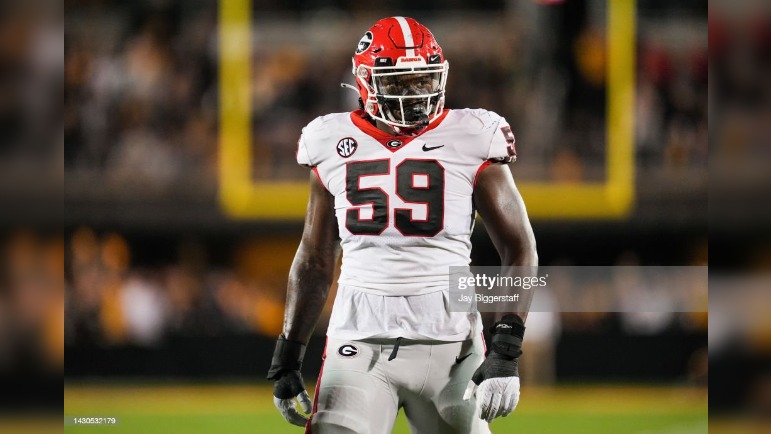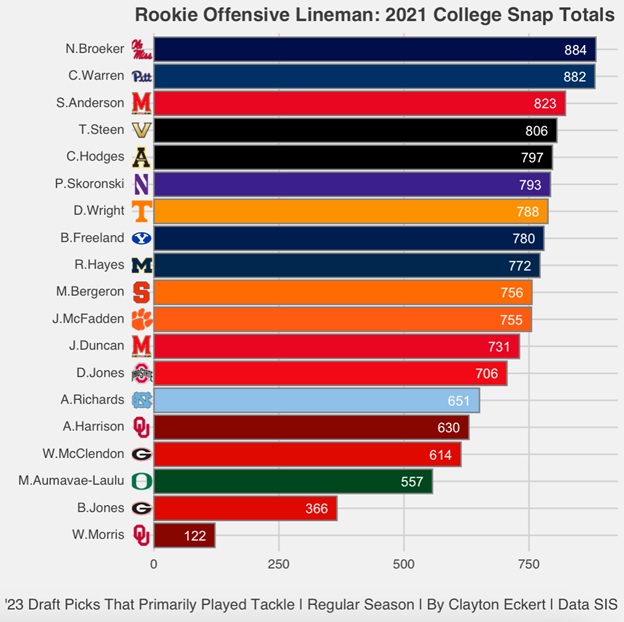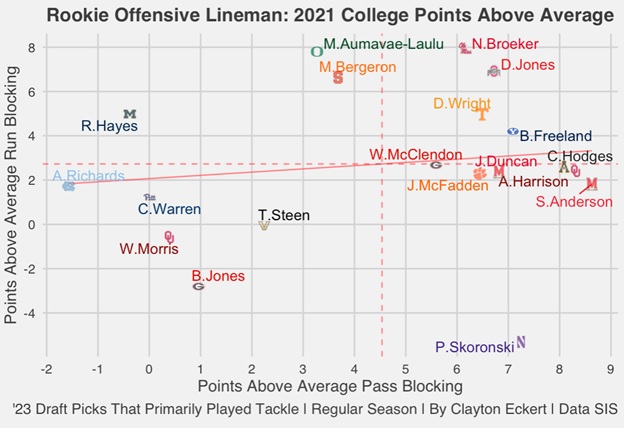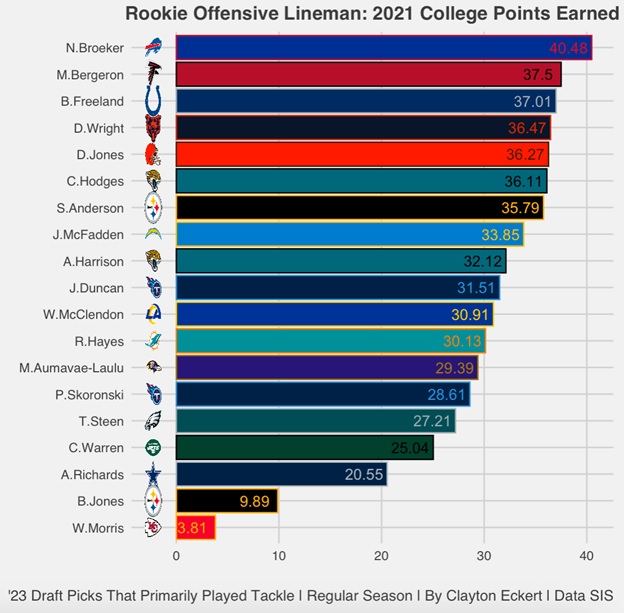The Pittsburgh Steelers selected two offensive lineman in 2023 draft: Georgia’s Broderick Jones with the 14th pick in round one and Maryland’s Spencer Anderson with the 251st pick in the seventh round. Following up my PFF grades article, today I wanted to revisit an article I did on Jones earlier in the offseason for 2021 using Sports Info Solutions (SIS) with some different parameters.
This study which will focus on players who heard their names called in the draft whose primary snap counts came at tackle in the 2021 regular season, which includes Anderson (who I’ll speak more on today). The goal is to see how they stacked up among their peers.
First, let’s look at snap opportunities:
Focusing through Steelers lenses, we see a substantial difference in snaps, with SIS charting Anderson for 823 which ranked third among the 19 qualifying players in 2021. He started in all 12 games, primarily at right tackle along with four games at center as well. Jones had 366 snaps per SIS which was second least, playing in nine games and starting in four of them behind Jamaree Salyer (sixth round pick in 2022). This is huge quantity context as we dive deeper and see how Pittsburgh’s investments fared.
Next, let’s add quality context in run and pass blocking with SIS’s points above average metric (The total of a player’s EPA responsibility while blocking using the Total Points system that distributes credit among all players on the field for a given play. For blockers, this includes accounting for blown blocks, yards before contact on running plays, and performance given the defenders in the box.):
In these terms, Anderson impressively had the top ranked points above average in pass blocking. This definitely aligns with his strengths and stronger play as a pass blocker highlighted well in our own Josh Carney’s draft profile, but was pleasantly surprised to see him atop the list. He was below the mean in run blocking though, as expected, ranking 13th but still landed above Jones in both data points (14th pass block, 18th run block). So, Anderson was interestingly much stronger in 2021 at right tackle and center particularly as a pass blocker, compared to plummeting to next to last in pass blocking and dead last in run blocking last season when he primarily played right guard.
To wrap up, let’s look at a more total blocking view with SIS’s points earned metric (The total of a player’s EPA responsibility while blocking using the Total Points system that distributes credit among all players on the field for a given play. Totals are scaled up to map to the average points scored or allowed on a team level, with the player’s snap count determining how much to adjust. For blockers, this includes accounting for blown blocks, yards before contact on running plays, and performance given the defenders in the box.) and which NFL teams made their dreams a reality by selecting them:
Anderson landed at seventh in points earned as a blocker overall, compared to ranking dead last in 2022 which is discouraging recency context. While we will of course need to sit back and watch how Anderson fares as his NFL journey begins, the data highlights where he succeeded and struggled very clearly. Jones landed next to last in points earned, and one of only two players with a number below 20. A main factor is his second least snaps of course, and made an encouraging leap with more opportunity last season ranking third.
Factoring in everything across my studies, Jones fared best in 2022 overall when he saw substantial playing time, including top five ranks in snaps (second), points earned (third), PFF pass block grade (third), and points above average pass blocking (fourth) which is encouraging recency context. He ranked a bit lower as a run blocker, landing at seventh in both PFF run block grade and SIS points above average.
In 2021, Jones was below average in every aspect in the SIS study, including points above average pass blocking (14th), along with the second least snaps, points above average run blocking, and points earned, while ranking a stronger 10th in PFF run block grade and 16th as a pass blocker. So, more disagreement between the grading services compared to aligned opinions last season, and an encouraging positive trajectory that’s great to see from the first-round pick on the optimistic side, though his lack of overall college experience is a concern that could lead to some growing pains.
Anderson unfortunately trended negatively overall, with better results in 2021 at right tackle and center, highlighted by a top ranked points above average pass blocking result, along with a top five rank in snaps (third), PFF pass block grade (fourth). He was also above average in points earned (seventh), but was below the mean in points above average run blocking (13th), and the third worst PFF run block grade. Then in 2022 when he played the vast majority at right guard, Anderson’s highest marks were a fourth ranked PFF pass block grade and the sixth highest snaps, but ranked next to last in PFF run block grade, SIS points above average pass blocking, and dead last in points above average run blocking and points earned.
Some varying opinions here as well, and the downtrend is notable, which likely factored into his services being available at the end of the draft. Hopefully Pittsburgh made a good decision on that flyer, and Anderson can bounce back from a less than desirable season. With time on his side to learn from those ahead of him on the depth chart, and encouraging play previously, this creates some optimism that it could happen. One thing’s for sure, I can’t wait to see how it shakes out.
Throughout the rest of the offseason, I will dive deeper into the data as we continue to learn about the newest Pittsburgh Steelers. How do you think Broderick Jones and Spencer Anderson will fare their rookie year? Thanks for reading and let me know your thoughts in the comments!











